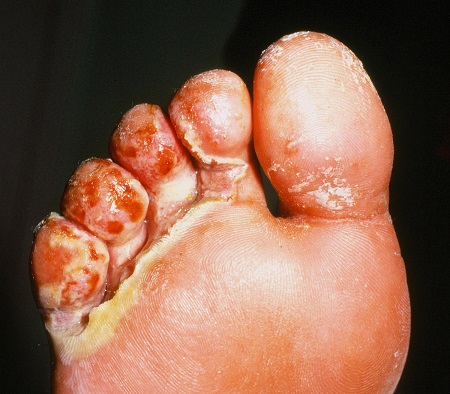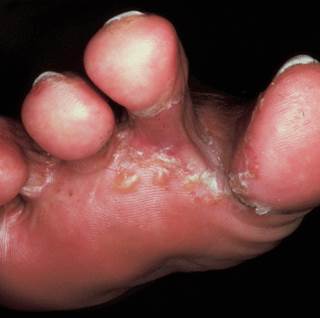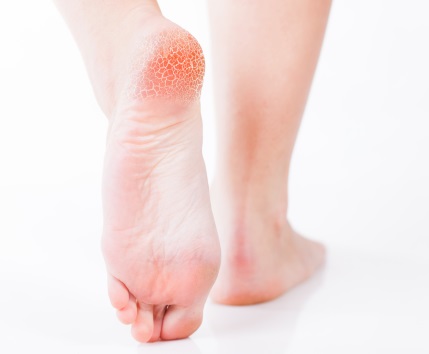Athlete’s Foot is a common fungal infection that can frequently affect teenage boys and adult men. Women and kids under the age of 12 can also get athlete’s foot fairly often as well. This infection is easy to treat but can also recur in those who are susceptible. The tiny germs that make up this infection seem to thrive in a moist, warm, and dark place, such as a shoe and prefer attaching to human skin.
What Does Athlete's Foot Look Like?
Tinea pedis, also known as athlete’s foot, usually shows symptoms on their victims through burning or itching skin on their feet. Scaling, cracking, and peeling of the feet are also warning signs off athlete’s foot as they vary from one person to another. While the skin may start off smooth and soft it can quickly begin to macerate. Here is a picture that answers the question, “What does athlete’s foot look like?”
1. Gram Negative or Toe Web Infection

The gram negative (also referred to as the toe infection or the interdigital), are some of most common versions of athlete’s foot. While it usually begins as a small infection between the two smallest toes, it can quickly spread to the other foot and even the hands. The skin starts out smooth so it may be hard to detect right away. If you detect an unpleasant odor, you can pretty much determine it is from a bacterial infection. Once the infection takes over the toenails, you should seek help for gram negative athlete’s foot.
2. Vesicular Infection

This type of infection is not as common as all the other types of athlete’s foot. While the first symptoms to show up are blisters, it’s the location of them that sets them apart from the other types of infection. They will most likely show up around the instep of the foot, on top of the foot, and also on the sole. Once you have vesicular athlete’s foot, you could find the blisters in the same places or they may have moved on to the fingers, arms and chest.
3. Moccasin Type Infection

Because this type of infection spreads across the base of the foot resembling a moccasin it is named after the casual shoe. Symptoms begin with dry, scaly and itching skin and then moves on to cracked, thickened, and peeling skin. If it progresses to the toenails this symptom may become worse with the nails becoming thick, an infection spreading on the foot and the toenails may begin to fall off.
Make sure that you are aware of "what does athlete's foot look like?" so you know when and how to react properly to get rid of it as soon as possible.
How Is Athlete's Foot Treated?
There are two main courses of action to keep in mind when dealing with athlete’s foot: first, keep the area as clean as possible; and secondly, put the practices and procedures in place so you don’t get the infection in the first place. Athlete’s foot is a term that began with the infections that ran rampant on the feet of sports fanatics who wore closed in shoes for long periods of time creating the perfect sweaty environment for this chronic fungal infection.
Keep Your Feet Clean and Dry
- Always keep your feet clean and dry them off, especially in between the toes which is where most of these infections strike first.
- Don’t wear the same shoes every day and see to it that the shoes you do wear are roomy. Gone from your wardrobe are vinyl shoes and added in are shoes that breathe and cotton socks.
- Medicated powders can work to help your feet stay dry. Check out medicated powders such as Lotrimin that includes miconazole in its list of ingredients.
- A holistic approach is a foot bath of one-part vinegar to four parts of water. You can implement this soak two times a day for 10 minutes each time.
Apply Antifungal Creams and Washes
Next up is the application of washes and creams that are antifungal in makeup. Look for the following ingredients when purchasing these products: terbinafine which can be found in Lamisil, econazole nitrate which can be found in Spectazole, and ketoconazole which you can find in Nizoral cream and shampoo.
Treat the Toenails
If you find that your infection has invaded your toenails you should seek an antifungal topical treatment that will prevent the chance of the toes becoming infected again. Toenails can often be ignored, leading to recurrent infections. When dealing with nail fungus, treatment will be up to four months so be patient when seeking results. Also oral antifungal medications may be prescribed to help.
How to Prevent It from Recurring
There are things you can do to not have to experience athete’s foot again. Any treatments you can implement will be worth it so at least you won’t have to ask, what does athlete’s foot look like again? There are additional things you can do to support your new plan of attack:
- Change your socks and shoes daily.
- Pick out your two favorite pair of shoes and switch them out every other week so they have a chance to completely dry out.
- Try to go barefoot or wear sandals and shoes that are made up of breathable materials.
- Dusting your feet with an antifungal powder every morning is a good habit to include in your daily routine.
- If you think despite your efforts you may be getting athletes foot again you should wash your towels and socks in the hottest water you can.
- When you are frequenting a public place that is based on water sports such as swimming, boating, or outdoor showers, make sure you wear footwear that is made up of water resistant materials.
